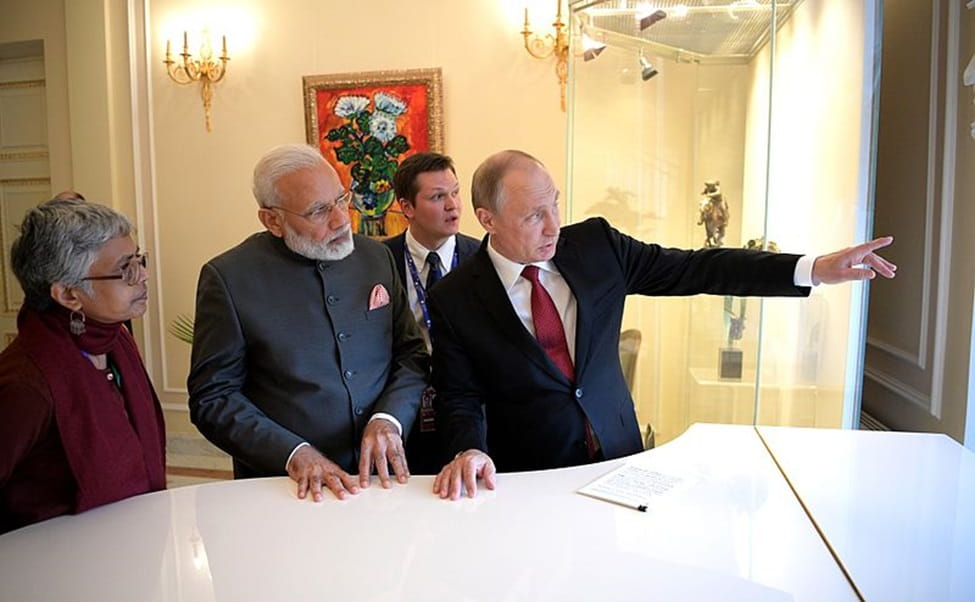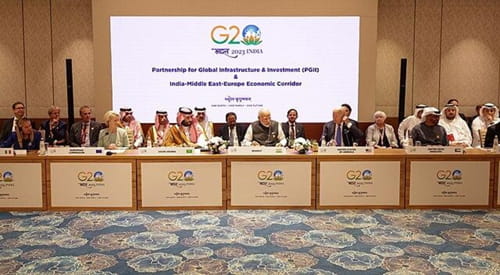
Indian Prime Minister Narendra Modi and President Vladimir Putin at the St Petersburg International Economic Forum, 2017.
India has benefitted from a multi-alignment foreign policy and used its potential for collaboration with all nations to further its own interests. The establishment of the INSTC through Iran and the Vladivostok-Chennai Sea route are additional assets for India’s strategic autonomy, and will assist in making bilateral economic cooperation no longer the weak link in Russian-Indian relations in future.
Introduction
Demand for transporting goods from Asia to Europe by rail via Russia has increased by an average of 30 percent since the start of the Red Sea crisis, the Financial Times reported, citing logistics companies and rail operators1. And German shipping company DHL said that requests to transport goods on Russian railways have increased by 40 percent since container ships began travelling along alternative routes following the Houthi attacks in the Red Sea. The Houthis, who control large parts of northern and western Yemen, vowed in November last year to attack ships associated with Israel until it halts its military actions in Gaza which led the United States to announce the creation of a multinational operation to secure navigation in the Red Sea. Later, USA and UK forces launched major strikes against Houthi positions in a bid to degrade the rebels’ ability to target commercial vessels but this has had limited deterrent effect.
Netherlands-based Rail Bridge Cargo said that rail freight traffic via Russia was 31 percent higher this year compared to the same period in 20232. Delivery of goods from China to Northern Europe via alternative sea routes has increased by 7-10 days to 50-55 days, while delivery of goods by train via Russia from China’s Chengdu to the German city of Duisburg takes about 30 days. Some logistics companies reportedly offer a ‘southern route’ that bypasses Russia and goes via Kazakhstan, Azerbaijan and Turkey, but this route, which involves a ferry crossing across the Caspian Sea, takes longer than a container ship voyage between China and Europe and can be used mainly for goods heading to and from Central Asian countries such as Uzbekistan.
The Ukraine War and Western-imposed sanctions have dramatically changed the directional flows of Russian trade which were historically with Europe. The new directions were to China to the east and India and countries of the Gulf to the south. Trade with China increased by 60 percent to $240 billion and with India by 400 percent to $65 billion3.
This has led to the establishment of new trade routes with infrastructure being built at a fast pace. A one hundred mile $1.7 billion railway line will be the final link between Russia and Iranian ports, making access to and from western ports of India reachable, and Russia is providing Iran credit to finance this project4. Travel time from St Petersburg to Mumbai should come down to 10 days opposed to 30 as of now. Moscow hopes this link will also help its two-way trade with Turkey. The proposed railway link should in 2028 connect Iran and Azerbaijan and thence to the Russian rail network.
The new element in assessing these logistics is the possibility of conflict in the West Asia region which began last year with Israel-Palestinian clashes and widened into a Israeli-Iranian conflict that has the potential to escalate into a wider war and the introduction of non-regional actors. The precariousness of the situation is undoubtedly a negative factor, whereas this article is based on the presumption of the preservation of the status quo.
International North–South Transport Corridor
As early as the late 1990s, a group of Indian, Iranian, and Russian transport companies, with the approval of their governments, signed a general agreement on export-import container transportation along the Sri Lanka-India-Iran-Caspian Sea-Russia transport corridor. An intergovernmental agreement followed in 2000, and in 2002, the transport ministers of the three countries signed an agreement to open the corridor.
Politicians and businesses welcomed the idea of the International North–South Transport Corridor (INSTC) as it promised economic benefits by shortening trade routes, minimising political risks in the absence of strong naval fleets, accelerating the development of infrastructure in Caspian ports, and upgrading Astrakhan and Makhachkala to the status of major transportation hubs. The use of the Western and Trans-Caspian corridors was seen as a way to revitalise Volga River traffic and cut costs on cargo deliveries to Сentral Russia.
India saw benefits to the project because it would strengthen ties with Russia and Iran and give access to Central Asian markets while bypassing Pakistan, with the possibility of delivering exports to Europe via Russia. But the reality became more complicated. The need to allocate financial resources to upgrade and maintain the project infrastructure, sanctions imposed on Iran, and the unstable situation in Afghanistan prevented the corridor from being viable. By 2022 and the Ukraine War, the hardships associated with the North-South route had exhausted several generations of Russian and Indian experts, but rapidly changing geopolitical realities have given the concept a new push.
As Russia and India stepped up bilateral economic cooperation, a plan that had almost been given up became operational. All three segments of the corridor, the western route (Russia- Azerbaijan- Iran-India), middle or Trans-Caspian route (Russia-Iran-India), and the eastern route (Russia-Central Asia-Iran-India) are nearly functional. But according to an estimate by Russian Railways, the corridor is currently operating at about half of its capacity, although it is difficult to calculate the exact volume of transported goods due to a significant share of ‘shadow operations’. It seems Russia and India have great opportunities to increase bilateral trade in manufactured goods, but logistics alone are not enough to achieve this goal.
Self-reliance for India
The main factor determining India’s foreign trade policy is the country’s macroeconomic model, which any of India’s trading partners, including Russia, must note. Since the launch of liberal reforms in the 1990s, India has come far in economic development. Prior to the financial crisis in 2008, the country’s annual GDP growth rate was close to 10 percent. After a brief setback, the economy has now recovered, and economists are deliberating whether this is the extent of India’s growth potential, and if another global slowdown were to occur, how it would impact the economy.
The Narendra Modi government after 2014 arrived at a conclusion that maintaining development required not only emphasising the tertiary services industry, but stimulating manufacturing. This would address several tasks – creating jobs, reducing dependence on foreign imports and forming a domestic base for a developed tertiary industry. This policy was reflected in the ‘Make in India’ initiative and Atmanirbhar Bharat program to locate international manufacturing facilities in India. In this context, entering India’s market to export to other countries requires Russian businesses to create joint enterprises with local companies, which means new and untried strategies for Russian business.
India’s transformation to an export-oriented industrial player is possible only in the long term. India’s political leadership is traditionally interested in developing the domestic market for both economic reasons – the high degree of government involvement in the economy, and the uneven development of different states – and social reasons, namely the need to fight poverty while meeting the growing demands of the middle class. When it comes to international markets, India faces competition from countries like China who have established dominance in certain niche sectors and have been industrialised for decades.
Fostering India-Russia Trade Growth
New Delhi had concerns about China’s Belt and Road Initiative (BRI) ever since the project was announced and especially frustrating for India was the inclusion of the Karakoram Highway in the China-Pakistan Economic Corridor (CPEC), which crosses Gilgit-Baltistan, an area of Kashmir disputed with Pakistan. As BRI expanded to India’s neighbourhood and West Asia, New Delhi’s concerns grew stronger.
In Sri Lanka, the port of Hambantota was handed to a Chinese company for to pay Sri Lankan debts, followed by a default on external obligations in 2022, which has reinforced the belief in India of the ‘debt-trap strategy’ employed by China, by which it is alleged Beijing deliberately burdens its counterparts with debt to establish dependence. India actively conveys this warning to others against close collaboration with China. Moscow understands why New Delhi is concerned about Beijing’s expanding influence and why India desires to enhance economic and technological collaboration with the USA. Nevertheless, there can be no denying that most Eurasian countries are attracted by the favourable capital and loan conditions offered by China.

PM Modi addresses the Partnership for Global Infrastructure and Investment & India-Middle East-Europe Economics Corridor event during G20 Summit, in New Delhi on September 09, 2023.
PM Modi addresses the Partnership for Global Infrastructure and Investment & India-Middle East-Europe Economics Corridor event during G20 Summit, in New Delhi on September 09, 2023.
In September 2023, during the G-20 Summit, plans were announced by the USA, India, UAE, Saudi Arabia and the EU to construct an India-Middle East-Europe Economic Corridor (IMEC) which would use Haifa port in Israel. However, this is postponed indefinitely due to the Israeli-Palestinian and Israeli-Iranian conflicts, which makes cooperation between the Arab world and Israel implausible at the present time. Yet, this is unlikely to be India’s last attempt to create an alternative to China’s BRI.
Conclusion
The global economy is increasingly fragmented, leading to two distinct platforms of manufacture/infrastructure, technology and artificial intelligence – one centred on the United States and the other on China. Meanwhile, India is faced with three tasks: fostering growth through its industrial sector, forging robust economic relationships with international partners, and positioning itself in the evolving global economy. These tasks are complementary and in order to accomplish each of them, New Delhi should best remain multi-aligned.
India has benefitted from a multi-alignment foreign policy and used its potential for collaboration with all nations to further its own interests. The establishment of the INSTC through Iran and the Vladivostok-Chennai Sea route are additional assets for India’s strategic autonomy, and will assist in making bilateral economic cooperation no longer the weak link in Russian-Indian relations in future.
(Exclusive to NatStrat)
Endnotes: